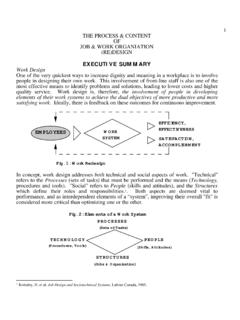Transcription of The history of Adventure Playgrounds - Fair Play For Children
1 Adventure Playgrounds Tony Chilton A BRIEF history Introduction I was prompted to write about the early developments of Adventure Playgrounds by a range of factors, particularly those referred to in the latter parts of this paper. Further to this however, I, along with many others connected to this area of work, became increasingly concerned that the fundamental philosophy underpinning the operational practices initiated by the pioneers of Adventure Playgrounds , was being somewhat misunderstood, forgotten and even disregarded. In addition, I am aware that many Playwork training programmes do not appear to emphasise the importance of the original concept. In determining this, I rely on my direct experience of being an Adventure playground Worker over a long period of time and a trainer involved in writing and delivering basic introductory courses through to degree and post-graduate levels of training.
2 When I expressed my intention, to a number of respected and appropriate people, to write about the history of Adventure Playgrounds , I was particularly encouraged by the support of my very dear friend and past work colleague, Professor Fraser Brown. Fraser was himself a lone Adventure playground Worker operating on an isolated site on a large social housing estate in the north west of England when I first met him many years ago. In preparing and writing this paper he has been tremendously helpful in offering his professional assistance in providing constructive assessment and human support for which I thank him unreservedly. 1) The Beginning The concept of what we now refer to as Adventure Playgrounds had its beginnings in the early 1940 s and perhaps even before.
3 As early as 1939 there were clear examples of a more enlightened approach to the provision of play areas, as indicated by a playground in Bolton, Lancashire. Here, instead of the traditional metal swings, slides and roundabouts, there was an abundance of unconventional wooden structures of a wide and stimulating variety. Elsewhere, a number of play sites throughout the UK witnessed the introduction of unusual play items such as old train engines, disused lifeboats, old buses and unwanted railway carriages. The latter two items were later often adapted to accommodate equipment storage and indoor play on emerging Adventure Playgrounds . The prospect for a more imaginative and exciting approach to play opportunities was being explored by a wide range of organisations including some forward thinking local authorities.
4 This was as a consequence of and a realisation that there was a need for more child oriented, clearly defined and dedicated spaces for Children s play - places where Children could express themselves in a free and unrestricted manner in response to their instinctive urge to explore, experiment, invent and extend their various and multi-faceted patterns of play behaviour. This was demonstrated by Children (and I was one of such!) who during and after World War II were often to be seen playing on bomb sites, lighting fires, building a variety of structures, mainly dens and the like, using the materials readily available there. If and where trees were to be found, Children invariably made swings, tree houses and such. In place trees, the cast iron arms of the street lampposts would be used for swings!
5 Such improvisation of course, reflected the imagination and play instincts of Children since time immemorial. There was a gallant effort to accommodate such play behaviour as highlighted by a project in Morden, Surrey and reported in the Evening News, November, 1947 when a Junk playground was created on waste ground with a grown-up who can help, but won t boss and the rest is up to Children . The newspaper went on to refer to similar developments elsewhere, for instance an Under-Fourteens Council suggested the scheme for our big cities. They stated that, Stepney and Shoreditch Councils have already reserved pieces of land for the scheme. Westminster has just bought two sites intending to use them as ordinary Playgrounds . This seems to be a chance to try out the idea in another area where it is badly needed.
6 Coincidently (and perhaps ironically), Morden was not only the possible birth place of the Adventure playground concept in the UK, but also the birth place of Fraser Brown, an Adventure playground Worker in the mid 1970s and the first Professor in Playwork in the ! How curious is that! When the junk playground concept began to gather momentum, it was clearly recognised by the early pioneers that provision needed to be a totally child centred environment where supervision was not so strictly applied. This was so that Children and young people could be free of unnecessary constraints and simply be themselves. They needed to be places which would be without adult imposed controls and intervention, as profoundly stated in the newspaper article referred to above; places where a grown up.
7 Won t boss - and the rest is up to Children . A clear enough statement of intent; it was to be an environment where there were no meaningless rules, regulations and play-restrictive controls. Development of such a concept was originally determined by Professor Carl Sorenson (1931), a landscape architect by profession. He arrived at a considered view of Children s play needs as a consequence of witnessing Children persistently accessing construction sites, bomb sites and landscape development areas in order to use loose materials for play experiences within such locations. Sorenson recognised the need for a place where Children could express their individual and collective imagination and creativity; a specific space available to Children when they most needed it when not in school evenings, weekends and all school holidays.
8 Sorenson s Junk playground as it was referred to, was established in 1943 in a small urban area, Emdrup just outside Copenhagen. It was provision which reflected Sorenson s idea that Children could create and shape, dream and imagine ; an understanding long since recognised as essential elements of primary play behaviour. The latter two are very often overlooked aspects of play, yet so much of this takes place in the child s mind. Children are frequently imagining, fantasising, creating, exploring and determining their play in their minds, much of which absorbs them for long periods of time. Of his concept, Sorenson (1951:314) stated .. of all the things I have helped to realise, the Junk playground is the ugliest; yet for me it is the best and most beautiful of my works.
9 Carl Sorenson also stressed that Children ought to be free of external controls in their play by determining for themselves how, when and where they played, thereby maximising the opportunities to establish their own play parameters to the greatest possible extent. With regard to this, it was suggested that adults ought to be exceedingly careful when seeking to intervene in the play lives, events and behaviour of Children . Such an approach was later reinforced by visionaries such as Drummond Abernethy and Lady Marjorie Allen. (Refer to sections 2 and 6) The appointment of a supervisor in the Emdrup situation, as was also the case in Morden, later to be referred to as a Play Leader, was considered to be required to ensure that dangerous and potentially harmful activities on the site were noted and Children offered assistance when asked for or needed.
10 It was generally agreed however, that Children had to consider their own capacity for confronting and dealing with risks. John Bertelson, the first Play Leader in Emdrup, also had responsibility for identifying potential sources for the regular supply of tools and materials. These were items such as timber, old tyres, ropes, nets and other resources provided so as to enable Children to have constant access to creative play opportunities. All such re-usable materials added to and helped develop their play experiences through imaginative and creative uses. Bertelson emphasised that: The purpose of the leader was not to govern Children from outside and direct their building activity to a useful goal, but rather to act from within, by allowing them to pursue their own projects (Kozlovsky 2007: 8).











